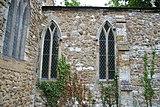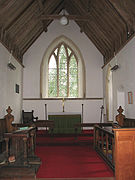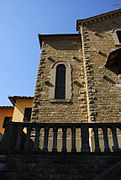A lancet window is a tall, narrow window with a pointed arch at its top.[1] It acquired the "lancet" name from its resemblance to a lance.[2] Instances of this architectural element are typical of Gothic church edifices of the earliest period. Lancet windows may occur singly, or paired under a single moulding, or grouped in an odd number with the tallest window at the centre.
The lancet window first appeared in the early French Gothic period (c. 1140–1200), and later in the English period of Gothic architecture (1200–1275). So common was the lancet window feature that this era is sometimes known as the "Lancet Period".[3]
The term lancet window is properly applied to windows of austere form, without tracery. Paired windows were sometimes surmounted by a simple opening such as a quatrefoil cut in plate tracery. This form gave way to the more ornate, multi-light traceried windowed.
Examples
Early English lancet windows, built 1234, east end of Southwell Minster, Nottinghamshire, England
Early English east window and series of nine lancet windows in the south wall of the choir, in the ruined Ardfert Cathedral, County Kerry, Ireland
Early English lancet windows in the Lady Chapel of Hereford Cathedral, Herefordshire, England
Late 13th century Y tracery in lancet windows of chancel of St Helen's church, Barnoldby le Beck, Lincolnshire, England
The triple lancet east window, c. 1300, in St Andrew's Church, Attlebridge, Norfolk, England
Left aisle with single lancet window in the medieval church of St Lucia in Galluzzo, Florence, Italy.
See also
- Church window
- Monofora
- Polifora
References
- ^ Buffalo Architecture Archived 5 September 2006 at the Wayback Machine, accessed 24 October 2006
- ^ Encyclopædia Britannica Online accessed 24 October 2006
- ^ Gothic Architecture in England accessed 24 October 2006
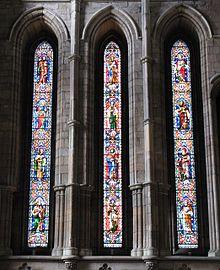
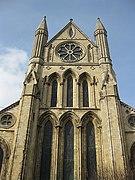
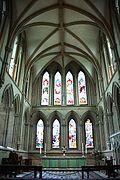
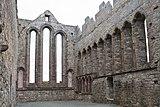
.jpg)
